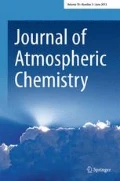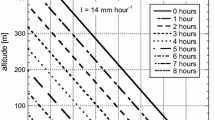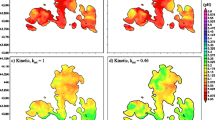Abstract
A one-dimensional cloud model with size-resolved microphysics and size-resolved aqueous-phase chemistry, driven by prescribed dynamics, has been used to study gas scavenging by weak precipitation developed from low-level, warm stratiform clouds. The dependence of the gas removal rate on the physical and chemical properties of precipitation has been explored under controlled initial conditions. It is found that the removal of four gaseous species (SO2, NH3, H2O2 and HNO3) strongly depends on the total droplet surface area, regardless the mean size of droplets. The removal rates also correlate positively with the precipitation rate, especially for precipitation having a mean radius larger than 20 μm. The dependence of the scavenging coefficients on the total droplet surface area is stronger than on the precipitation rate.
The removal rates of SO2, NH3 and H2O2 by precipitation strongly depend on the others' initial concentrations. When NH3 (or H2O2) concentration is much lower than that of SO2, the removal rate of SO2 is then controlled by the concentration of H2O2 (or NH3). The removal of NH3 (or H2O2) also directly depends on the concentration of SO2. NH3 and H2O2 can also indirectly affect each other's removal rate through interaction with SO2. The scavenging coefficient of SO2 increases with the concentration ratio of NH3 to SO2 if the ratio is larger than 0.5, while the scavenging coefficient of NH3 increases with the concentration ratio of SO2 to NH3 when the ratio is smaller than 1. The scavenging coefficient of H2O2 generally increases with the concentration ratio of SO2 to H2O2. Although the Henry's law equilibrium approach seems to be able to simulate gas scavenging by cloud droplets, it causes large errors when used for simulating the scavenging of soluble gas species by droplets of precipitating sizes.
Similar content being viewed by others
References
Ackerman, A. S., Hobbs, P. V., and Toon, O. B., 1995: A model for particle microphysics, turbulent mixing, and radiative transfer in the stratocumulus-topped marine boundary layer and comparisons with measurements. J. Atmos. Sci. 52, 1204–1236.
Audiffren, N., Renard, M., Buisson, E., and Chaumerliac, N., 1988: Deviations from the Henry's law equibrium during cloud events. Atmos. Res. 49, 139–161.
Barth, M. C., Rasch, P. J., Kiehl, J. T., Benkovitz. C. M., and Schwartz, S. E., 2000: Sulfur chemistry in the National Center for Atmospheric Research community climate model: description evaluation features, and sensitivity to aqueous chemistry. J. Geophys. Res. 105, 1387–1415.
Barth, M. C., Stuart, A. L., and Skamarock, W. C., 2001: Numerical simulations of the July 10 Stratospheric–Tropospheric Experiment: Radiation, Aerosols, and Ozone/Deep Convection storm: Redistribution of soluble tracers. J. Geophys. Res. 106, 12381–12400.
Berkowitz, C. M., Easter, R. C., and Scott, B. C., 1989: Theory and results from a quasi-steady-state precipitation-scavenging model. Atmos. Environ. 23, 1555–1571.
Chaumerliac, N., Leriche, M., and Audiffren, N., 2000: Modeling of scavenging processes in clouds: some remaining questions about the partitioning of gases among gas and liquid phases. Atmos. Res. 53, 29–43.
Crutzen, P. J. and Lawrence, M. G., 2000: The impact of precipitation scavenging on the transport of trace gases: A 3-D dimensional model sensitivity study. J. Atmos. Chem. 37, 81–112.
Djouad, R., Sportisse, B., and Audiffren, N., 2002: Numerical simulation of aqueous-phase atmospheric models: use of a non-autonomous Rosenbrock method. Atmos. Environ. 36, 873–879.
Easter, R. C., and Hales, J. M., 1983: Interpretations of the OSCAR data for reactive gas scavenging. In Precipitation Scavenging, Dry Deposition, and Resuspension, edited by Pruppacher, H. R., Semonin, R. G. and Slinn, W. G. N., Elsevier, Sci., New York, 649–662.
Fahey, K. M. and Pandis, S. N., 2003: Size-resolved aqueous-phase atmospheric chemistry in a three- dimensional chemical transport model. J. Geophys. Res. 108, 4690, doi:10.1029/2003JD003564.
Feingold, G., Kreidenweis, S. M., and Zhang, Y., 1998: Stratocumulus processing of gases and cloud condensation nuclei. Part 1. Trajectory ensemble model. J. Geophys. Res. 103, 19527–19542.
Giorgi, F. and Chameides, W., 1986: Rainout lifetimes of highly soluble aerosols and gases as inferred from simulations with a general circulation model, J. Geophys. Res. 91, 14367–14376.
Grégoire, P. J., Chaumerliac, N., and Nickerson, E. C., 1994: Impact of cloud dynamics on tropospheric chemistry: advances in modeling the interactions between microphysical and chemical physics. J. Atmos. Chem. 18, 247–266.
Gurciullo, C. S. and Pandis, S. N., 1997: Effect of composition variations in cloud droplet populations on aqueous-phase chemistry. J. Geophys. Res. 102, 9375–9385.
Herrmann, H., Ervens, B., Jacobi, H.-W., Wolke, R., Nowacki, P., and Zellner, R., 2000: CAPRAM2.3: A chemical aqueous phase radical mechnism for tropospheric chemistry. J. Atmos. Chem. 36, 231–284.
Jacobson, M. Z., 1997: Fundamentals of Atmospheric Modeling. Cambridge University Press.
Jaenicke, R., 1993: Tropospheric aerosols. In P. V. Hobbs ed: Aerosol-cloud-climate interactions, 1–31.
Kreidenweis, S. M., Walcek, C. J., Feingold, G., Gong, W., Jacobson, M. Z., Kim, C. H., Liu, X., Penner, J. E., Nenes, A., and Seinfeld, J. H., 2003: Modification of aerosol mass and size distribution due to aqueous-phase SO2 oxidation in clouds: Comparisons of several models. J. Geophys. Res. 108, 4213, doi 10.1029/2002JD002697.
Laj, P., Fuzzi, S., Facchini, M. C., Lind, J. A., Orsi, G., Preiss, M., Maser, R., Jaeschke, W., Seyffer, E., Helas, G., Acker, K., Wieprecht, W., Moeller, D., Arends, B. G., Moels, J. J., Colvile, R. N., Gallagher, M. W., Beswick, K. M., Hargreaves, K. J., Storeton-West, R. L., and Sutton, M. A., 1997: Cloud processing of soluble gases. Atmos. Environ. 31, 2589–2598.
Lelieveld, J., and Crutzen, P. J., 1991: The role of clouds in tropospheric photochemistry. J. Atmos. Chem. 12, 229-267.
Mari, C., Jacob, D. J., and Bechtold, P., 2000: Transport and scavenging of soluble gases in a deep convective cloud. J. Geophys. Res. 105, 22255–22267.
Mizak, C. A., Campbell, S. W., Luther, M. E., Carnahan, R. P., Murphy, R. J., and Poor, N. D., 2005: Below-cloud ammonia scavenging in convective thunderstorms at a coastal research site in Tampa, FL, USA. Atmos. Environ. 39, 1575–1584.
Rasch, P. J., Feichter, J., Law, K., Mahowald, N., Penner, J., Benkovitz, C., Genthon, C., Giannakopoulos, C., Kasibhatla, P., Koch, D., Levy, H., Maki, T., Prather, M., Roberts, D. L., Roelofs, G. J., Stevenson, D., Stockwell, Z., Taguchi, S., Kritz, M., Chipperfield, M., Baldocchi, D., McMurry, P., Barrie, L., Balkanski, Y., Chatfield, R., Kjellstrom, E., Lawrence, M., Lee, H. N., Lelieveld, J., Noone, K. J., Seinfeld, J., Stenchikov, G., Schwartz, S., Walcek, C., and Williamson, D., 2000: A comparison of scavenging and deposition processes in global models: results from the WCRP Cambridge Workshop of 1995. Tellus 52B, 1025-1056.
Ravishankara, A. R., 1997: Heterogeneous and multiphase chemistry in the troposphere. Science 276, 1058-1065.
Roelofs, G. J. H., 1993: A cloud chemistry sensitivity study and comparison of explicit and bulk cloud model performance. Atmos. Environ. 27A, 2255–2264.
Roelofs, G. J. and Lelieveld, J., 1995: Distribution and budget of O3 in the troposphere calculated with a chemistry general circulation model. J. Geophys. Res. 100, 20983–20998.
Seinfeld, J. H. and Pandis, S. N., 1997: Atmospheric Chemistry and Physics: From Air Pollution to Global Change. John Wiley and Sons, New York, p1326.
Sellegri, K., Laj, P., Marinoni, A., Dupuy, R., Legrand, M., and Preunkert, S., 2003: Contribution of gaseous and particulate species to droplet solute composition at the Puy de Dôme, France. Atmos. Chem. Phys. 3, 1509–1522.
Stefan, S. and Mircea, M., 2003: Sensitivity of the precipitation scavenging coefficient of nitric acid vapor to raindrop size distribution. Romanian Reports in Physics 55, 76–81.
Toon, O. B., Turco, R. P., Westphal, D., Malone, R., and Liu, M. S., 1988: A multi-dimensional model for aerosols: Description of computational analogs. J. Atmos. Sci. 45, 2123–2143.
Viosin, D., Legrand, M., and Chaumerliac, N., 2000: Scavenging of acidic gases (HCOOH, CH3COOH, HNO3, HCl and SO2) and ammonia in mixed liquid-solid water clouds at the Puy de Dôme mountain (France). J. Geophys. Res. 105, 6817–6835.
Wurzler, S., 1998: The scavenging of nitrogen compounds by clouds and precipitation: part II. The effects of cloud microphysical parameterization on model predictions of nitric acid scavenging by clouds. Atmos. Res. 47-48, 219–233.
Yin, Y., Parker, D. J., and Carslaw, K. S., 2001: Simulation of trace gas redistribution by convection clouds – Liquid phase processes. Atmos. Chem. Phys. 1, 19–36.
Zhang, L., Michelangeli, D. V., and Taylor, P. A., 2004: Numerical studies of aerosol scavenging in low-level, warm stratiform clouds and precipitation. Atmos. Environ. 38, 4653–4665.
Zhang, L., Michelangeli, D. V., Djouad, R., and Taylor, P. A., 2005a: Modelling studies of the sulphur cycle in low-level, warm stratiform clouds. Atmos. Res, in press.
Zhang, L., Michelangeli, D. V., and Taylor, P. A., 2005b: Influence of aerosol concentration on precipitation formation in low-level, warm stratiform clouds. J. Aerosol Sci, in press.
Zhang, Y., Kreidenweis, S. M., and Feingold, G., 1999: Stratocumulus processing of gases and cloud condensation nuclei. Part 2: Chemistry sensitivity analysis. J. Geophys. Res. 104, 16061–16080.
Author information
Authors and Affiliations
Corresponding author
Rights and permissions
About this article
Cite this article
Zhang, L., Vet, R. & Michelangeli, D.V. Numerical Investigation of Gas Scavenging by Weak Precipitation. J Atmos Chem 54, 203–231 (2006). https://doi.org/10.1007/s10874-005-9010-x
Received:
Accepted:
Published:
Issue Date:
DOI: https://doi.org/10.1007/s10874-005-9010-x




